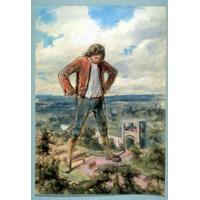
©
http://www.jaffebros.com/lee/gulliver/images.html
(Paul Gavarni)
A Critical Review of Gulliver's Travels |
|
|
Jonathan Swift's story, Gulliver's Travels, is a very clever story. It recounts the fictitious journey of a fictitious man named Lemuel Gulliver, and his travels to the fantasy lands of Lilliput, Brobdinag, Laputa, and Houyhnhmn land. When one first reads his accounts in each of these lands, one may believe that they are reading humorous accounts of fairy-tale-like lands that are intended to amuse children. When one reads this story in the light of it being a satire, the stories are still humorous, but one realizes that Swift was making a public statement about the affairs of England and of the human race as a whole.
In the beginning of the story, Gulliver explains to the reader a bit about his background, why he was on these journeys to begin with, and where he finds himself at the beginning of his tale. The story begins with Gulliver recounting how he was shipwrecked the land of Lilliput. He awakens to find himself tied down and held captive by a tiny race of people. To the inhabitants of Lilliput, Gulliver is something of a giant. He could not move, because he was tied down, but he notices a a race of tiny people moving about him. These people take all of his possessions for inspection, for they are in awe and fear of his great size. They feed him, and soon untie him but still keep him in confinement. While in his confinement, he is visited by the emperor who likes Gulliver. Gulliver learns there language and the customs of the people of Lilliput. In this book Swift, by describing the ludicrous system that Lilliput's government fashions in, is satirizing the English system of governing. He uses parallels that seem absurd at first glance but make more senses when looked at carefully.
When Gulliver reaches the land of Brobdinag, he finds himself in the exact opposite situation that he was in when in Lilliput. In Brobdinag, it is Gulliver who is the tiny person, and the inhabitants of that land who appear to be giants. Gulliver expects these "giants to be monsters", but soon finds that they are a peaceful race of people, who live in a sort of peace-loving land. Swift was playing on all people's fear of being frightened by those who appear different looking or more powerful.
In recounting third journey, Gulliver visits the land of Laputa. The stories that are contained within are a satire on specific figures and policies of the British government of the period in which Swift lived. This is probably, out of all of the parts of this story that are commonly read today, the least widely read. This is because most people today do not know of whom Swift is referring to.
When Gulliver reaches the land of the Houyhnhnms, we read a very fine story that we can still relate to today. There is a distinction made between the two type of people Gulliver encounters in this land. The Yahoos, who are considered to be uncivilized Neanderthals, and the Houyhnhnms, who Gulliver's considers to be civilized. Gulliver contends that the Houyhnhnms are civilized because they are similar to him, the people remind him of English people, and they have the most complex language he has run across in his travels. We also read in this part of his travels of a war between the Big-Endians and the Little-Endians, who are at war with one another over which end of a hard boiled egg should be cracked on. Swift is satirizing the futility of wars over things like religion.
Gulliver soon returns home in wonder over his journeys to these
lands. Swift did a excellent job of hiding a biting criticism of the government
and society in which he lived. He did this by making the characters in the story
so fantastic and foreign to the reader that the story could only be a fairy
tale, written for children. The actions of the people he runs across are so
absurd, and Gulliver seems so innocent, that at first read many people didn't
even get what Swift was trying to say. There were, however, people who knew
Swift's intentions from the start, and got all of the symbols in the story.
© http://courses.ncsu.edu/classes/eng251001/Gullivercrit.htm